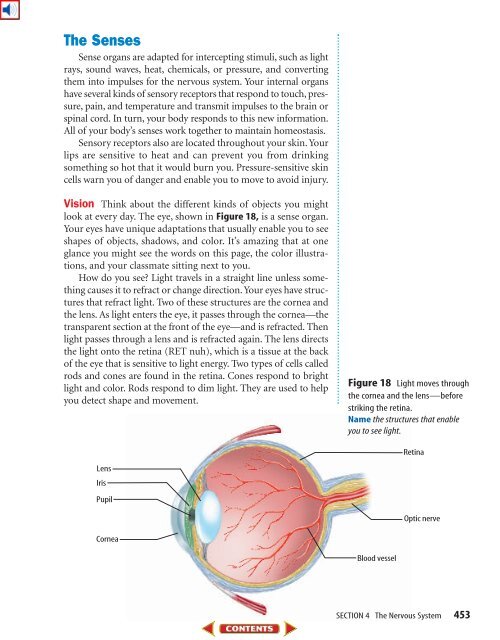Chapter 15: Support, Movement, and Responses - Science
Chapter 15: Support, Movement, and Responses - Science
Chapter 15: Support, Movement, and Responses - Science
You also want an ePaper? Increase the reach of your titles
YUMPU automatically turns print PDFs into web optimized ePapers that Google loves.
The Senses<br />
Sense organs are adapted for intercepting stimuli, such as light<br />
rays, sound waves, heat, chemicals, or pressure, <strong>and</strong> converting<br />
them into impulses for the nervous system. Your internal organs<br />
have several kinds of sensory receptors that respond to touch, pressure,<br />
pain, <strong>and</strong> temperature <strong>and</strong> transmit impulses to the brain or<br />
spinal cord. In turn, your body responds to this new information.<br />
All of your body’s senses work together to maintain homeostasis.<br />
Sensory receptors also are located throughout your skin. Your<br />
lips are sensitive to heat <strong>and</strong> can prevent you from drinking<br />
something so hot that it would burn you. Pressure-sensitive skin<br />
cells warn you of danger <strong>and</strong> enable you to move to avoid injury.<br />
Vision Think about the different kinds of objects you might<br />
look at every day. The eye, shown in Figure 18, is a sense organ.<br />
Your eyes have unique adaptations that usually enable you to see<br />
shapes of objects, shadows, <strong>and</strong> color. It’s amazing that at one<br />
glance you might see the words on this page, the color illustrations,<br />
<strong>and</strong> your classmate sitting next to you.<br />
How do you see? Light travels in a straight line unless something<br />
causes it to refract or change direction. Your eyes have structures<br />
that refract light. Two of these structures are the cornea <strong>and</strong><br />
the lens. As light enters the eye, it passes through the cornea—the<br />
transparent section at the front of the eye—<strong>and</strong> is refracted. Then<br />
light passes through a lens <strong>and</strong> is refracted again. The lens directs<br />
the light onto the retina (RET nuh), which is a tissue at the back<br />
of the eye that is sensitive to light energy. Two types of cells called<br />
rods <strong>and</strong> cones are found in the retina. Cones respond to bright<br />
light <strong>and</strong> color. Rods respond to dim light. They are used to help<br />
you detect shape <strong>and</strong> movement.<br />
Lens<br />
Iris<br />
Pupil<br />
Cornea<br />
Figure 18 Light moves through<br />
the cornea <strong>and</strong> the lens—before<br />
striking the retina.<br />
Name the structures that enable<br />
you to see light.<br />
Blood vessel<br />
Retina<br />
Optic nerve<br />
SECTION 4 The Nervous System 453
















